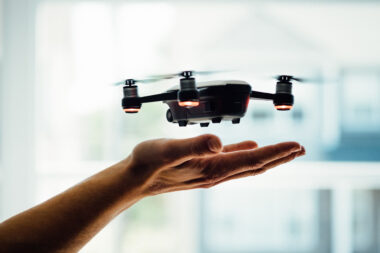Introduction
Supersonic parachutes are cutting-edge deceleration systems designed to safely slow down and land spacecraft or payloads traveling at supersonic speeds. Traditional parachutes face challenges in supersonic or hypersonic conditions due to increased aerodynamic forces and heating. Supersonic parachutes, equipped with advanced features like Supersonic Inflatable Aerodynamic Decelerators (SIADs) and Disk-Gap-Band (DGB) designs, address these challenges. They play a crucial role in space exploration missions, ensuring controlled descents and safe landings for spacecraft re-entering Earth’s atmosphere or other celestial bodies. By inflating at higher altitudes and managing intense aerodynamic forces, supersonic parachutes contribute to the success of missions at the forefront of aerospace engineering.
The principle of supersonic parachutes
The principle of supersonic parachutes revolves around managing the aerodynamic challenges and intense forces encountered during the descent of spacecraft or payloads traveling at supersonic speeds. Key principles include:
- Increased Drag Area:
- Supersonic parachutes aim to maximize the drag area, the force opposing the spacecraft’s motion, to efficiently decelerate it.
- Components like Supersonic Inflatable Aerodynamic Decelerators (SIADs) or Disk-Gap-Band (DGB) parachutes are designed to inflate and increase the effective drag area.
- Aerodynamic Stability:
- Maintaining stability during descent is critical. Parachute designs incorporate features to prevent uncontrolled spinning or oscillations, ensuring a stable and predictable descent.
- Heat Management:
- The intense aerodynamic forces during supersonic descent generate significant heat. Supersonic parachutes use specialized materials and design features to manage and dissipate this heat, preventing damage to the parachute canopy.
- Controlled Deployment:
- Advanced deployment systems, such as pilot chutes, mortars, or other mechanisms, are employed to ensure the controlled and timely inflation of the parachute system.
- Altitude-Triggered Deployment:
- Supersonic parachutes are designed to deploy at higher altitudes compared to traditional parachutes. This altitude-triggered deployment optimizes the deceleration process and enhances overall control.
- Integration with the Main Parachute:
- The supersonic parachute system is often part of a multi-stage deceleration strategy. It works in tandem with a main parachute, which is deployed at lower altitudes for the final phase of the descent.
- Adaptability to Atmospheric Conditions
- Supersonic parachutes must adapt to varying atmospheric conditions, especially during re-entry into different celestial bodies’ atmospheres. Designs consider factors like atmospheric density and pressure.
- Materials and Structural Integrity:
- High-strength, heat-resistant materials are crucial for the parachute canopy’s construction, ensuring structural integrity and reliability under extreme conditions.
- Precision in Descent:
- The design and deployment of supersonic parachutes aim for precision in descent, allowing for targeted landings and ensuring the safety of the spacecraft or payload.
- Continuous Research and Optimization:
- The principles of supersonic parachutes are continually refined through research and development. Engineers seek to optimize designs, materials, and deployment strategies to enhance the performance of these critical aerospace components.
Materials used in making supersonic parachutes
- Nylon Fabric:
- High-strength nylon fabric is a common material for parachute canopies.
- Properties: Nylon offers excellent tensile strength, tear resistance, and durability.
- Significance: Its robust properties make it suitable for withstanding the dynamic forces experienced during supersonic descent.
- Kevlar Fabric:
- Kevlar is a synthetic aramid fiber used in parachute construction.
- Properties: It is known for its exceptional strength and heat resistance.
- Significance: Kevlar enhances the parachute’s ability to withstand high temperatures and mechanical stresses during descent.
- Mylar Film:
- Mylar, a type of polyester film, is used as a heat-resistant layer.
- Properties: Mylar provides thermal insulation and protection against radiant heat.
- Significance: It helps manage the intense heat generated during supersonic descent, preventing damage to the parachute.
- Nomex Cloth:
- Nomex is a flame-resistant aramid fabric.
- Properties: It is known for its fire-resistant properties and high-temperature stability.
- Significance: Nomex is often used in parachute construction to enhance resistance to heat, especially during re-entry.
- Dyneema Fibers:
- Dyneema is a high-performance polyethylene fiber used in parachute lines.
- Properties: Dyneema offers exceptional strength, low stretch, and high abrasion resistance.
- Significance: Dyneema lines contribute to the overall strength and reliability of the parachute system.
- Heat-Resistant Coatings:
- Specialized coatings, often based on silicone or other heat-resistant materials, are applied to the parachute fabric.
- Properties: These coatings provide additional protection against heat and abrasion.
- Significance: They enhance the overall heat resistance of the parachute canopy.
- Reinforcement Materials:
- Additional layers of reinforcing materials, such as tapes or webbing, are integrated into critical areas of the parachute.
- Properties: These reinforcements add strength and durability to specific sections of the parachute.
- Significance: They ensure the integrity of the parachute under extreme conditions.
- Structural Components:
- Structural components like support rings and load-bearing elements are often made from lightweight, high-strength alloys or composites.
- Properties: These materials provide structural integrity without adding excessive weight.
- Significance: They contribute to the overall stability and reliability of the parachute system.
The combination of these materials ensures that supersonic parachutes can withstand the complex and demanding conditions of high-speed descents, allowing for the safe and controlled landing of spacecraft or payloads during space exploration missions.
Working of supersonic parachutes
The working of supersonic parachutes involves a carefully orchestrated sequence of events to safely decelerate and land spacecraft or payloads traveling at supersonic speeds. Here is a step-by-step breakdown of how supersonic parachutes operate:
- Deployment Sequence:
- The deployment sequence begins when the spacecraft or payload reaches a predetermined altitude suitable for parachute deployment.
- Deployment mechanisms, such as pilot chutes or mortars, initiate the release of the supersonic parachute system.
- Canopy Inflation:
- The main parachute canopy starts to inflate as it is exposed to the oncoming airflow.
- Inflation is a critical phase, and the parachute canopy rapidly expands to its full size.
- Aerodynamic Drag:
- The inflated parachute canopy generates significant aerodynamic drag as it interacts with the air.
- This drag force acts in the opposite direction to the motion of the descending spacecraft, inducing deceleration.
- Descent Control:
- The parachute system is designed to provide controlled descent, preventing excessive oscillations or spinning.
- Aerodynamic and structural features ensure stability during descent, allowing for a predictable and controlled landing.
- Supersonic Inflatable Aerodynamic Decelerators (SIADs):
- In some designs, supersonic inflatable aerodynamic decelerators (SIADs) may be employed to enhance drag and stability.
- SIADs deploy at higher altitudes and help manage aerodynamic forces during supersonic descent.
- Heat Management:
- Supersonic descents generate significant heat due to air friction.
- Specialized materials and coatings on the parachute canopy dissipate heat and protect the parachute from thermal stress.
- Line Stretch and Load Distribution:
- Parachute lines, typically made of high-strength materials like Dyneema, experience tension during descent.
- The stretch and elasticity of the lines help distribute the load evenly across the parachute system.
- Final Descent and Landing:
- As the spacecraft nears the ground, the parachute system gradually reduces the descent speed.
- The final descent and landing are controlled, ensuring a gentle and safe touchdown for the spacecraft or payload.
- Main Parachute and Redundancy:
- In many supersonic parachute systems, redundant systems support the main parachute.
- Redundancy enhances reliability, providing a backup in case of any unforeseen issues with the primary parachute.
- Data Collection and Telemetry:
- Throughout the descent, data collection and telemetry systems onboard the spacecraft continuously monitor and transmit information about the descent process.
- This data is crucial for evaluating the performance of the parachute system and informing future design improvements.
The working of supersonic parachutes involves a combination of aerodynamics, material science, and engineering precision to ensure a safe and controlled descent. These parachutes play a pivotal role in the success of space exploration missions, enabling spacecraft to return to Earth or other celestial bodies with precision and reliability.
Algorithm
Designing an in-depth algorithm for supersonic parachutes involves intricate considerations to ensure a controlled descent under various conditions. Below is a detailed breakdown of the algorithm, focusing on key aspects:
1. Deployment Algorithm:
- Objective: Determine the optimal altitude for parachute deployment.
- Inputs:
- Altitude data from onboard altimeters
- Velocity data.
- Mission-specific parameters (e.g., target landing site, atmospheric conditions).
- Algorithm Steps:
- Continuously monitor altitude and velocity.
- Calculate the descent rate and estimate the time to impact.
- Consider mission parameters to determine the optimal deployment altitude.
- Factor in safety margins and redundancy considerations.
- Trigger parachute deployment based on the calculated optimal altitude.
2. Inflation and Drag Control:
- Objective: Achieve controlled and rapid inflation of the parachute.
- Inputs:
- Accelerometer data for detecting deployment
- Atmospheric pressure data
- Algorithm Steps:
- Upon deployment, monitor acceleration to detect inflation.
- Adjust venting mechanisms to control the rate of inflation.
- Use pressure sensors to gauge atmospheric conditions for drag force adjustments.
- Maintain a balance between rapid inflation and controlled descent.
3. Aerodynamic Stability Algorithm:
- Objective: Ensure stable descent by adjusting the parachute’s aerodynamic profile.
- Inputs:
- Gyroscope data for detecting rotation
- Wind speed and direction data
- Algorithm Steps:
- Continuously monitor rotation and orientation using gyroscopic data.
- Analyze wind conditions to predict aerodynamic forces acting on the parachute.
- Adjust control surfaces or canopy shapes to maintain stability.
- Implement feedback loops to respond dynamically to changing conditions.
4. Redundancy Management:
- Objective: Manage and deploy redundant parachute systems if necessary.
- Inputs:
- Health status of primary and backup parachute systems.
- Algorithm Steps:
- Regularly assess the health of primary and backup systems.
- Determine the operational status of each parachute.
- If issues are detected in the primary parachute, autonomously trigger the deployment of the backup system.
5. Descent Trajectory Optimization:
- Objective: Optimize the descent trajectory for precision landing.
- Inputs:
- GPS data.
- Terrain mapping information
- Algorithm Steps:
- Utilize GPS data to track the spacecraft’s position.
- Analyze terrain maps to identify obstacles and safe landing zones.
- Optimize the descent trajectory based on real-time data and pre-mission planning.
6. Heat Management Algorithm:
- Objective: Prevent thermal stress on the parachute materials.
- Inputs:
- Temperature data from heat sensors
- Algorithm Steps:
- Continuously monitor temperature changes during descent.
- Adjust the orientation of the parachute to distribute heat evenly.
- Implement cooling mechanisms if necessary to prevent material degradation.
7. Altitude and Velocity Control:
- Objective: Achieve a smooth transition from supersonic to subsonic speeds.
- Inputs:
- Altitude and velocity data
- Algorithm Steps:
- Monitor altitude and velocity throughout the descent.
- Gradually adjust parachute parameters to smoothly transition from supersonic to subsonic speeds.
8. Data Fusion and Sensor Integration:
- Objective: Create a comprehensive understanding of the development environment.
- Inputs:
- Data from altimeters, accelerometers, gyroscopes, and other sensors
- Algorithm Steps:
- Fuse data from various sensors to create a unified picture of the descent environment.
- Use sensor fusion algorithms to mitigate errors and enhance accuracy.
9. Decision-Making Algorithms:
- Objective: Enable autonomous decision-making based on real-time data.
- Inputs:
- Sensor data.
- Mission parameters.
- Algorithm Steps:
- Implement decision trees or logic based on predefined mission objectives.
- Continuously evaluate sensor data to adapt to changing conditions.
- Autonomously make decisions regarding parachute parameters and system status.
10. Telemetry and Communication Algorithms:
1. Monitor telemetry data for system health and mission status.
2. Adjust communication parameters based on signal strength and environmental conditions.
3. Prioritize critical telemetry data for transmission to ground control.
This in-depth algorithm for supersonic parachutes incorporates a holistic approach to address deployment, aerodynamics, redundancy, trajectory optimization, heat management, and decision-making. The successful implementation of such algorithms ensures the reliability and precision of supersonic parachute systems in the challenging conditions of space descent.
Conclusion
Supersonic parachutes epitomize the marriage of innovation and precision in aerospace engineering. These remarkable devices, meticulously designed and rigorously tested, serve as indispensable guardians for the safe descent of spacecraft and payloads. As humanity ventures into the cosmos, supersonic parachutes stand as silent sentinels, orchestrating controlled descents with a symphony of aerodynamics, materials science, and engineering finesse. Their development over time, which is characterized by improvements and lessons learned, reflects our dedication to pushing the boundaries of exploration. In the grand narrative of space exploration, supersonic parachutes play a crucial role, ensuring that our quest for knowledge and discovery extends safely from the heavens to Earth’s surface.



